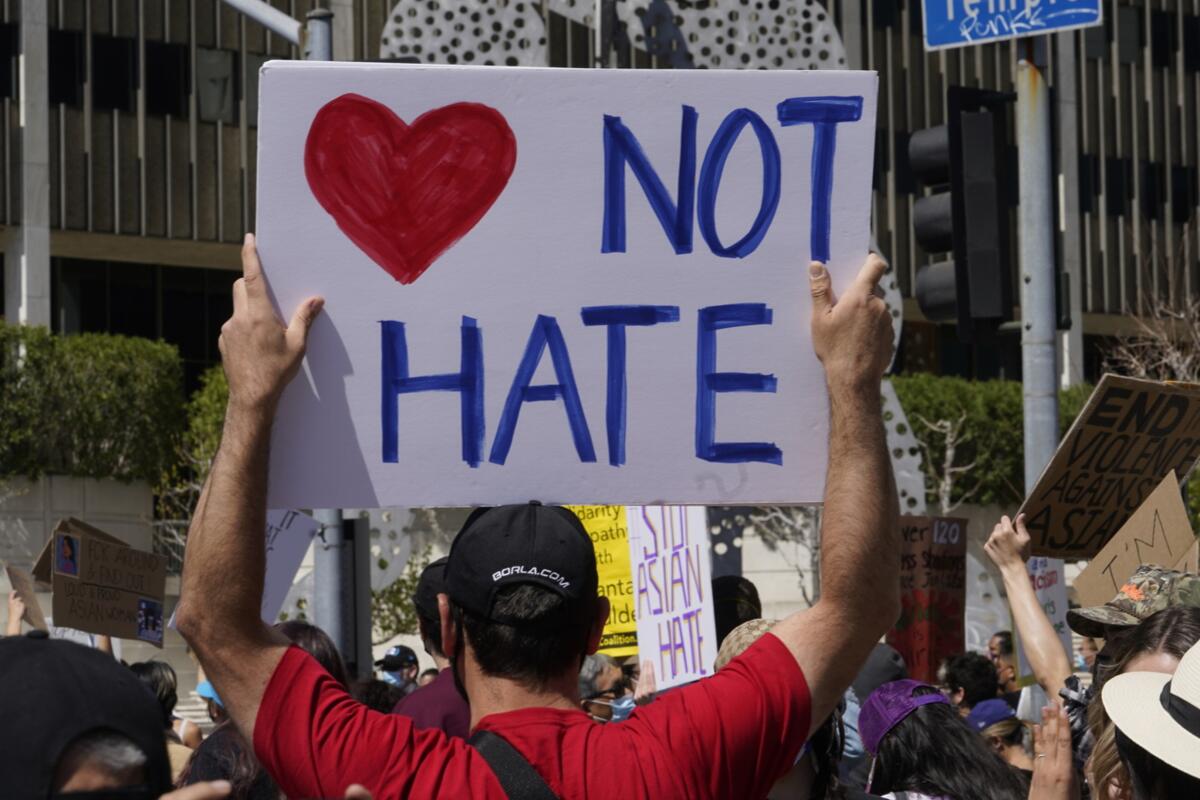FBIâs latest hate crimes report missing crucial data from California, New York and Florida

The FBI on Monday released its 2021 tally of hate crimes, but the report falls dramatically short of offering an accurate national snapshot: it excludes data from a swath of law enforcement agencies â including Los Angeles and New York.
The FBIâs annual roundup of hate crimes statistics was based on data from 65% of the nationâs roughly 18,800 law enforcement agencies, down from 93% in 2020.
Even so, the annual report documented 7,262 criminal incidents motivated by race, religion, sexual orientation or other factors in 2021 â lower than 8,263 in 2020, but high considering the lapse in agency participation.
Associate Atty. Gen. Vanita Gupta attributed the decline in data from key metropolitan areas and states to a technological shift: the federal agency recently switched to a different system for law enforcement agencies to report crime data under the National Incident-Based Reporting System (NIBRS) and agencies that had not yet transitioned were not able to submit hate crime statistics to the FBI.
âThe Justice Department continues to work with the nationâs law enforcement agencies to increase the reporting of hate crime statistics to the FBI to ensure we have the data to help accurately identify and prevent hate crimes,â Gupta said in a statement.
The absence of a third of law enforcement agencies â including some of the nationâs largest cities â makes it tricky for criminologists, policymakers and historians to draw meaningful conclusions about national hate crime trends.
In California, only 15 of 740 law enforcement agencies submitted 2021 data to the FBI through the new data system. That meant only 73 hate crime incidents were tallied in the state by the FBI for California â far below the 1,339 documented by the FBI in 2020.
Participation was even lower in Florida: only two of 757 law enforcement agencies in that state submitted data via the new portal and only one hate crime was reported.
Some experts said the FBI report should never have been published.
âItâs a critically flawed, incomplete document that fails to capture the fundamental elements that criminologists want to know,â said Brian Levin, director of the Center for the Study of Hate and Extremism at Cal State San Bernardino, who urged the FBI to amend the report. âYou canât leave out nearly all of California and Florida!â
Levin said the FBI statistics were particularly disappointing because they did not capture what he believed to be a significant national rise in hate crimes. If just New York City and Californiaâs 2021 figures were added to the mix, the national totals would jump past 9,000 for only the second time since the FBI began collecting hate crimes data in 1991.
Levin, who compiles his own hate-crimes database drawn from Freedom of Information Act requests and agency websites, noted that much of the information was not difficult to obtain. Back in June, the California attorney generalâs office announced a surge of 1,763 hate crimes in 2021.
The precipitous decline in the number of participating agencies â many of them among the highest reporting and reliable agencies â made the FBI report âunintentionally deceptiveâ in documenting overall trends, Levin said. It also failed to accurately represent increases in reported attacks against particular groups, like Asians and Jews.
Earlier this year, the Center for the Study of Hate and Extremism published a report that showed a 20% increase in hate crimes in 2021, with a 224% increase in anti-Asian crime.
âWe were looking at a record year for anti-Asian hate crimes,â Levin said. âWe counted more anti-Asian hate crimes in just 21 cities than the FBI counted nationwide.â
While the FBI showed a reduction in hate crimes against Jews, he said, his own groupâs research found a significant increase.
The FBI is required by federal law to collect hate crime data from federal, state, local, tribal and university law enforcement agencies as part of the Uniform Crime Reporting program. But participation is mandatory only for federal law enforcement.
Summarizing the 2021 data, the FBI said that 65% of victims were targeted because of the offendersâ bias against their race, ethnicity or ancestry, 16% due to sexual-orientation, 13% due to religion and 4% due to gender identity.
The FBI also noted that more agencies were using NIBRS in 2022.
âAs more agencies transition to the NIBRS data collection with continued support from the Department of Justice, hate crime statistics in coming years will provide a richer and more complete picture of hate crimes nationwide,â the agency said in a statement.
Some civil rights groups condemned law enforcement agenciesâ failure to provide local information via the NIBRS system.
âThe failure of thousands of police agencies across the country to participate in this report is devastating for the individuals and communities harmed by these crimes and to our ability to understand and prevent them,â Margaret Huang, the Southern Poverty Law Centerâs President and CEO, said in a statement.
Until legislation requires law enforcement agencies to report hate crimes, Huang said, federal funds to agencies should be conditioned on thorough hate crimes reporting or meaningful community hate crime prevention.
âWe can and must do betterâ Huang said.
Orlando Martinez, the hate crimes coordinator for the Los Angeles Police Department, said his agency was working on installing the NIBRS system, but did not yet have the program in place. Still, he emphasized that his agency was not holding anything back: it had submitted hate crime statistics via an online portal to the California Dept. of Justice.
In 2021, Martinez said, LAPD reported 616 hate crime incidents, up significantly from 359 in 2020.
âEven though weâre not in the computer database that everybodyâs looking at, they have our stats,â Martinez said. âIt is just not in that format.â
Just last week, a report released by the county Commission on Human Relations found that hate crimes in 2021 climbed by 20% in Los Angeles County over 2020, to their highest level in 20 years. Racially motivated crimes jumped 17%, the report said, with Black people disproportionately targeted and comprising nearly half of racial hate crime victims.
A key reason for the spike is that Los Angeles county has made it easier to report hate crimes in recent years. In 2020, officials launched the LA vs Hate program, which includes a âReport Hateâ hotline for reporting âacts of verbal or physical aggression, refusal of service, bullying, or intimidation of any kind that is motivated by hostile prejudice.â
Civil rights advocates have long complained that the FBI figures are an undercount. Local police forces, they argue, are insufficiently trained in how to identify hate crimes and frequently do not have enough motivation or resources to investigate hate crime allegations. Another challenge is that victims of hate crimes donât always report to the police.
âThe data need not be perfect,â Levin said. âBut when it is this incomplete, it becomes an obstacle, because the average American will look at it and say, âOh, OK, hate crimes are down.â
More to Read
Sign up for Essential California
The most important California stories and recommendations in your inbox every morning.
You may occasionally receive promotional content from the Los Angeles Times.











